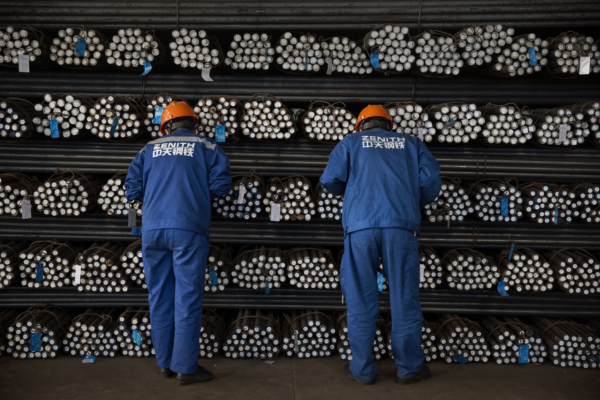China’s domestic market continues to struggle, prompting steel manufacturers to export excess products to the international market in order to survive. This has led to a surge in China’s steel exports in the first half of the year, with some countries conducting anti-dumping investigations. Experts warn that this could exacerbate trade conflicts between the US and China.
In the first six months of this year, China exported 53 million tons of steel, a 24% increase compared to the same period last year. The total annual export volume may reach a historical high of around 110 million tons, close to the record set in 2015.
At the same time, inventories of Chinese steel manufacturers are rapidly increasing, indicating worsened overcapacity. Around 4 million tons of inventory have been added to steel manufacturers since around 2020, according to Nikkei Asia.
Due to weak domestic demand and stockpiling, companies are turning to exports. Major steel companies have noted that with the increase in Chinese exports, prices of hot-rolled coil in the Southeast Asian market have plummeted from around $700 to $900 per ton in 2021 to the range of $510 to $520 per ton.
The recent settlement price of hot-rolled coil futures on the Chicago Mercantile Exchange has also dropped significantly from over $1,000 at the end of last year to around $660.
On Monday, Indian authorities submitted the “Economic Survey 2023-2024” to parliament, warning that the continuous slump in the Chinese property market since 2021 has led to severe overcapacity in the Chinese steel industry, further causing a sharp decline in global alloy prices.
The report cautioned that the poor performance of the Chinese real estate sector since 2021 has resulted in severe overcapacity, leading to a collapse in global steel prices, putting tremendous pressure on producers in India, Vietnam, Brazil, and other countries.
The report stated that China’s overcapacity poses a threat to other countries, especially emerging market and developing economies (EMDEs).
More and more EMDEs are implementing import restrictions on Chinese goods while accelerating free trade elsewhere to protect their domestic manufacturers. China has begun retaliating against these restrictions, making the manufacturing landscape in EMDEs more complex.
According to reports from the Vietnam General Department of Customs, steel imports hit a record high in the first half of this year, exceeding 8.22 million tons, a 48% increase in volume and 25% in value compared to the same period last year.
The import price in June was $727 per ton, a 17% decrease from the same period last year. In June alone, Vietnam imported 886,000 tons of hot-rolled coil, equivalent to 151% of domestic production, with 77% of it coming from China.
To address the risk of rampant cheap imports of hot-rolled coil, Vietnamese experts suggest that relevant institutions continue to establish quality management standards, technical barriers, and take trade remedies to prevent inferior products from entering the market.
The export of major Japanese steel manufacturers is also being impacted by the drop in steel prices. Nippon Steel stated in a briefing in May that the price decline in overseas markets due to the abundance of Chinese products would drag down profitability for the fiscal year 2024, estimating a potential decrease of 90 billion yen (approximately $573 million) compared to the fiscal year 2023.
Nippon Steel President Tadashi Imai stated, “We must strategize under the assumption of continued high production levels in China, which will force us to face a severe operating environment.”
As of April, Japan’s steel imports have been rising year-on-year for 15 consecutive months, with imports from China surging by 86%.
Although China’s overall crude steel production slightly surpassed 1 billion tons last year, its exports were relatively small. However, as the world’s largest crude steel producer, accounting for more than half of the global output, if domestic demand weakens, its surplus capacity could disrupt the global market.
The last time China’s steel exports surged, global leaders discussed addressing overcapacity at the G7 and G20 summits in 2016, leading to the establishment of the Global Forum on Steel Excess Capacity (GFSEC).
China withdrew from the GFSEC in 2019, claiming to have fulfilled its mission. However, despite capacity reductions from 2016 to 2018, Chinese capacity began to rise again from 2019.
To date, China’s steel overcapacity continues to worsen.
According to research from Sumitomo Corporation’s global research center, the Chinese authorities conducted an investigation into domestic steel manufacturers and trading companies in April and announced nationwide actions to contain crude steel production. However, crude steel production increased by 2.7% in May, indicating no progress in production cuts.
Industry insiders told Nikkei Asia that some believe local Chinese governments want to avoid deterioration in employment and fiscal conditions, hence encouraging the status quo.
China’s maneuvering of steel through third countries or other means to circumvent anti-dumping measures and indirect exports is raising concerns in many countries. As of early July, the number of anti-dumping investigations launched against Chinese products globally has increased from 3 cases last year to 10 this year.
Analysts believe that if domestic production overcapacity worsens, Beijing may devalue the yuan to stimulate exports and boost the economy.
Toru Nishihama, Chief Economist at the Dai-ichi Life Research Institute in Tokyo, told Nikkei Asia, “Trade tensions between the US and China are inevitably set to intensify, especially with the US presidential election approaching.”

